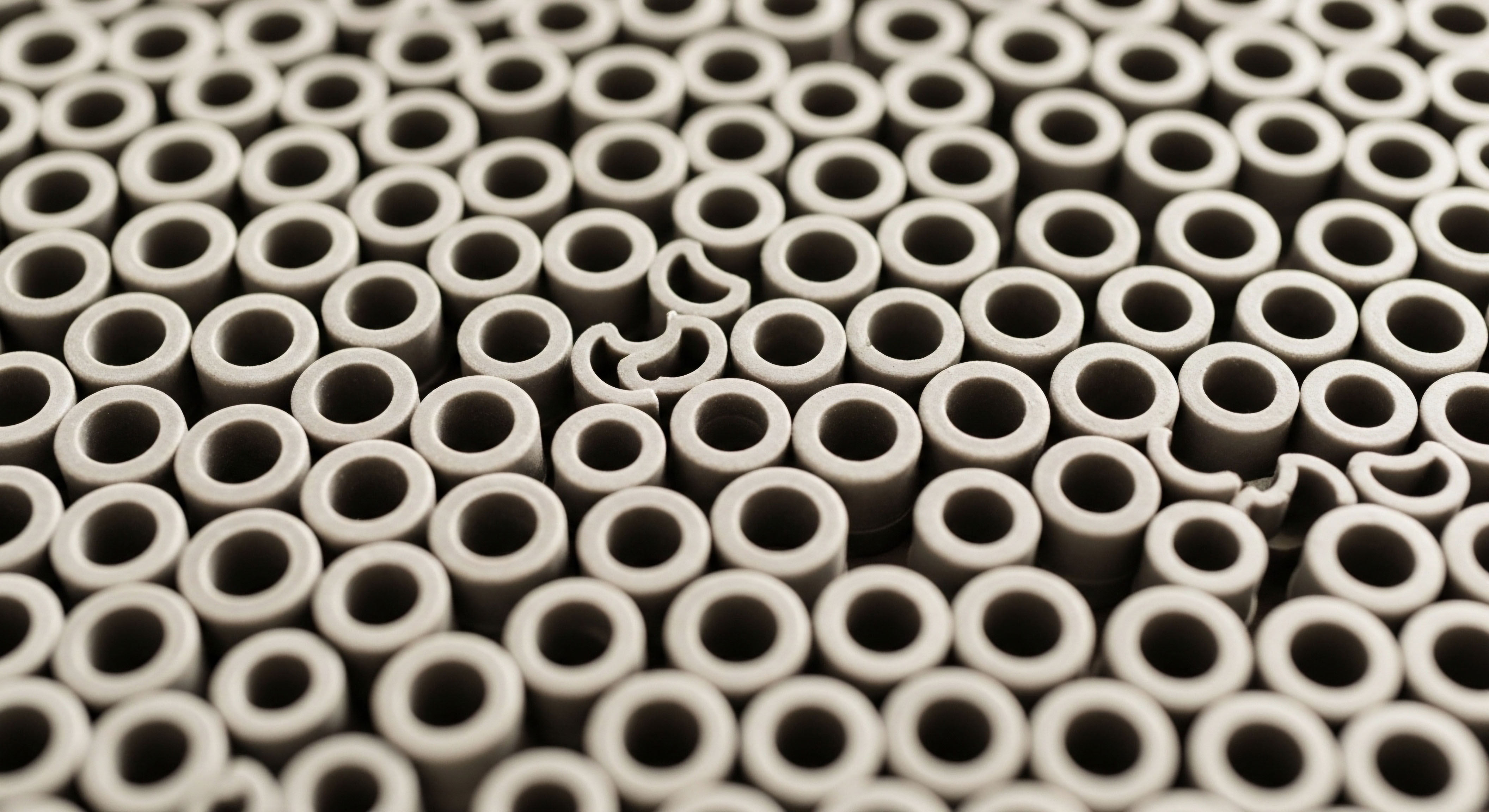

Fundamentals
You have embarked on a path of hormonal optimization, a precise clinical protocol designed to restore a fundamental aspect of your vitality. Yet, the results may feel inconsistent, or perhaps the profound sense of well-being you anticipated remains just out of reach. This experience is common and deeply human.
The reason often resides within the biological environment in which these therapeutic hormones operate. A hormonal protocol provides a specific molecular message. The way your body receives and acts upon that message is profoundly shaped by your daily lifestyle choices, particularly your diet and physical activity.
Consider your body as an intricate communication network. Hormones are the messengers, carrying vital instructions from one part of the system to another. For a message to be received clearly, the recipient ∞ in this case, the cell ∞ must have a functional receiver, known as a hormone receptor.
The number and sensitivity of these receptors are not static. They are dynamically regulated by your metabolic health. A diet high in processed foods and sugars can contribute to a state of insulin resistance, a condition where cells become less responsive to the hormone insulin. This cellular “deafness” can extend to other hormonal signals, potentially dampening the intended effects of your protocol. Your body is trying to listen; your lifestyle determines how well it can hear.

The Cellular Environment
Every cell in your body is bathed in a biochemical milieu that you create with every meal and every period of activity or rest. This environment dictates cellular behavior. Nutritious, whole foods provide the raw materials for cellular repair and optimal function. They supply the cofactors and vitamins necessary for hormone synthesis and metabolism.
Conversely, a nutrient-poor diet can create a state of low-grade, chronic inflammation. This systemic inflammation acts like static on a communication line, interfering with the delicate signals of your endocrine system and potentially blunting the efficacy of your hormonal therapy.
Your daily habits cultivate the biological terrain where your hormonal protocol will either flourish or struggle.
Physical activity is another powerful modulator of this environment. Exercise improves blood flow, ensuring that therapeutic hormones are efficiently delivered to their target tissues throughout the body. It enhances insulin sensitivity, making your cells more receptive to hormonal messages. Regular movement helps regulate cortisol, the primary stress hormone, which can otherwise interfere with the function of sex hormones like testosterone and estrogen. Through these mechanisms, exercise prepares your body to make the most of the therapeutic support you are providing.

What Is Hormonal Bioavailability?
The concept of bioavailability is central to understanding this relationship. When you administer a hormone, a certain portion of it circulates in the bloodstream bound to proteins, primarily Sex Hormone-Binding Globulin (SHBG) and albumin. Only the “free” or unbound portion is biologically active and available to bind with cell receptors.
Lifestyle factors significantly influence SHBG levels. For instance, high insulin levels can suppress SHBG production by the liver. This leads to a complex dynamic where more of a hormone might be “free,” but the underlying insulin resistance means the cells are less able to use it. A well-structured diet and exercise plan helps normalize both insulin and SHBG, creating a more balanced and efficient hormonal state where your protocol can work as intended.


Intermediate
To appreciate how lifestyle choices modulate hormonal protocols, we must examine the specific physiological mechanisms at play. Your diet and exercise habits are powerful epigenetic inputs, instructing your genes on how to regulate hormonal balance. They directly influence the key proteins and metabolic pathways that determine how your body utilizes both endogenous and prescribed hormones.
This is a system of profound interconnectedness, where the efficacy of a Testosterone Replacement Therapy (TRT) protocol for a man or a menopause support protocol for a woman is directly tied to their metabolic health.

The Role of Insulin Sensitivity
Insulin sensitivity is arguably the master regulator of metabolic health and, by extension, hormonal efficiency. A diet centered on whole foods with adequate protein, healthy fats, and complex carbohydrates from vegetables helps maintain stable blood glucose levels. This stability prevents the large, sustained spikes in insulin that characterize insulin resistance.
For a man on TRT, high insulin levels can suppress the production of Sex Hormone-Binding Globulin (SHBG). While this might initially seem to increase free testosterone, the underlying insulin resistance impairs the androgen receptor’s ability to respond to that testosterone.
The result is a diminished clinical effect despite what may appear to be adequate hormone levels on a lab report. A low-glycemic diet enhances cellular sensitivity, ensuring that the testosterone provided by the protocol can effectively exert its influence on muscle, bone, and brain tissue.
Lifestyle interventions function as sensitizers, amplifying the body’s ability to respond to a given hormonal signal.
For a woman undergoing hormone therapy for perimenopause or post-menopause, insulin sensitivity is just as important. Insulin resistance is closely linked to increased aromatase activity. Aromatase is the enzyme responsible for converting androgens (like testosterone) into estrogens. In a state of insulin resistance, particularly when accompanied by excess adipose tissue, this conversion can be accelerated.
This may disrupt the intended balance of a hormonal protocol, potentially leading to side effects associated with estrogen dominance. A structured nutrition plan, combined with exercise, helps control this enzymatic activity, ensuring the hormonal balance you and your clinician are working to achieve is maintained.

Exercise as a Hormonal Signal Amplifier
Physical activity acts as a potent modulator of hormonal physiology. Different types of exercise elicit distinct and beneficial responses that support hormonal protocols. Understanding these differences allows for the creation of a truly synergistic lifestyle plan.
- Resistance Training ∞ This form of exercise is paramount for improving insulin sensitivity. The muscular contractions involved in lifting weights stimulate glucose uptake into the muscle cells through pathways that are independent of insulin. This reduces the burden on the pancreas and improves overall glycemic control. For individuals on TRT, resistance training also directly stimulates androgen receptors in muscle tissue, making them more responsive to testosterone. This synergy is key to achieving desired changes in body composition and strength.
- High-Intensity Interval Training (HIIT) ∞ HIIT is exceptionally effective at improving mitochondrial density and function. Mitochondria are the energy powerhouses of our cells, and their health is vital for all metabolic processes, including the synthesis and signaling of hormones. Short bursts of intense effort followed by recovery periods have been shown to significantly enhance insulin sensitivity and support a healthy metabolic rate, creating a favorable environment for any hormonal therapy.
- Aerobic Exercise ∞ Steady-state cardiovascular exercise, like brisk walking, jogging, or cycling, improves cardiovascular health and circulation. This ensures the efficient delivery of hormones to target tissues. It also plays a significant role in managing stress by regulating cortisol levels. Chronic elevation of cortisol can suppress the function of the entire Hypothalamic-Pituitary-Gonadal (HPG) axis, undermining the body’s natural hormone production and the effectiveness of exogenous support.
By strategically combining these modalities, you create a physiological environment that is primed to respond optimally to your prescribed hormonal protocol. The table below outlines how specific lifestyle inputs can influence key hormonal mediators.
| Lifestyle Factor | Primary Mechanism of Action | Impact on Hormonal Protocol |
|---|---|---|
| Low-Glycemic Nutrition | Reduces insulin spikes and improves insulin sensitivity. | Increases cellular receptor sensitivity; helps normalize SHBG levels. |
| Resistance Training | Stimulates androgen receptors and non-insulin mediated glucose uptake. | Enhances the anabolic and metabolic effects of testosterone. |
| Adequate Protein Intake | Provides amino acids for muscle repair and stabilizes blood sugar. | Supports changes in body composition and reduces glycemic variability. |
| Sufficient Sleep | Regulates cortisol and supports nocturnal hormone production (e.g. Growth Hormone). | Optimizes the HPG axis and improves overall systemic recovery. |


Academic
A clinical hormonal protocol introduces a specific exogenous molecule into a complex, adaptive biological system. Its ultimate efficacy is determined by a cascade of interactions at the cellular and systemic levels, which are heavily influenced by non-pharmacological inputs. Diet and exercise are not merely supportive adjuncts; they are powerful modulators of the pharmacodynamics of hormonal therapies.
They achieve this by altering receptor sensitivity, the activity of metabolic enzymes, and the concentration of binding globulins, thereby dictating the biological impact of a given hormone concentration.

Quantitative Impact on Sex Hormones and Binding Globulins
Rigorous clinical investigation has quantified the profound effects of lifestyle interventions on the hormonal milieu. A randomized controlled trial published in the Journal of Clinical Oncology provides compelling data on this subject. The study examined overweight to obese postmenopausal women, a population where the interplay between metabolic health and hormone levels is particularly significant.
The results demonstrated that a 12-month intervention combining a reduced-calorie diet and moderate-to-vigorous aerobic exercise led to statistically significant changes in key sex hormones.
Specifically, the combined diet and exercise group experienced a 20.3% decrease in serum estradiol and an 11.1% decrease in estrone. This effect is largely attributable to weight loss, which reduces the volume of peripheral adipose tissue. Adipose tissue is a primary site of aromatase activity, the enzyme that converts androgens to estrogens.
By reducing the substrate for this enzyme, the intervention directly curbed peripheral estrogen synthesis. Furthermore, the study documented a remarkable 25.8% increase in Sex Hormone-Binding Globulin (SHBG) in the diet and exercise group. This elevation in SHBG, driven by improved insulin sensitivity and reduced hepatic fat, leads to a decrease in the bioavailable fractions of sex hormones.
For instance, free estradiol and free testosterone decreased by 26.0% and 15.6%, respectively. This illustrates a powerful principle ∞ lifestyle interventions can fundamentally shift the balance between bound and unbound hormones, a critical factor in managing conditions sensitive to hormone levels.

How Does Exercise Directly Modulate Hormonal Pathways?
The influence of exercise extends beyond caloric expenditure and weight management. Physical activity initiates a cascade of molecular signaling that directly impacts hormonal axes. Research involving postmenopausal women has shown that a 12-week program of aerobic exercise combined with dietary restriction significantly alters hormonal and metabolic markers.
One of the key findings was a significant inverse relationship between the change in SHBG levels and the Homeostatic Model Assessment for Insulin Resistance (HOMA-IR) index. As SHBG levels rose, HOMA-IR, a measure of insulin resistance, fell. This demonstrates that exercise-induced improvements in insulin sensitivity are biochemically linked to the liver’s production of SHBG. By improving how the body handles glucose, exercise directly recalibrates the transport proteins that govern hormone availability.
This has direct implications for therapeutic protocols. For a man on a TRT regimen that includes an aromatase inhibitor like Anastrozole, improved metabolic health through diet and exercise can reduce the baseline level of aromatization, potentially allowing for a lower effective dose of the medication.
For a woman on a carefully balanced hormone protocol, these lifestyle-driven changes in SHBG and estradiol can mean the difference between therapeutic success and the emergence of side effects. The table below synthesizes data from clinical research to show the direction of change in key biomarkers following a combined diet and exercise intervention.
| Biomarker | Observed Change (Diet + Exercise) | Primary Physiological Driver |
|---|---|---|
| Estradiol (Total) | Significant Decrease | Reduced aromatase activity from fat loss. |
| Sex Hormone-Binding Globulin (SHBG) | Significant Increase | Improved insulin sensitivity and hepatic function. |
| Free Testosterone | Significant Decrease | Increased binding to elevated SHBG. |
| Insulin Resistance (HOMA-IR) | Significant Decrease | Enhanced cellular glucose uptake and reduced inflammation. |
| Estrone | Significant Decrease | Reduced peripheral conversion in adipose tissue. |

What Are the Implications for the Hypothalamic-Pituitary-Gonadal Axis?
The HPG axis is the master regulatory circuit for sex hormone production, operating via a sensitive negative feedback loop. Lifestyle factors exert significant influence over this axis. Chronic psychological stress and poor sleep elevate cortisol, which can have a suppressive effect at the level of the hypothalamus and pituitary, dampening the entire downstream cascade.
Conversely, intense exercise can acutely stimulate the axis, while chronic, excessive exercise without adequate recovery can also become a stressor that suppresses it. A well-regulated lifestyle, incorporating restorative sleep and stress management alongside a balanced exercise program, creates a stable and resilient HPG axis.
For an individual on a protocol that includes agents like Gonadorelin, which directly stimulates this axis to maintain natural testosterone production, a healthy lifestyle ensures the system is responsive and capable of answering the therapeutic signal. The protocol does not exist in a vacuum; its success depends on the functional integrity of the biological systems it seeks to influence.

References
- McTiernan, A. et al. “Reduced-Calorie Dietary Weight Loss, Exercise, and Sex Hormones in Postmenopausal Women ∞ Randomized Controlled Trial.” Journal of Clinical Oncology, vol. 30, no. 15, 2012, pp. 1-10.
- Al-Saeed, W. Y. et al. “Aerobic exercise with diet induces hormonal, metabolic, and psychological changes in postmenopausal obese women.” Journal of Advanced Pharmaceutical Technology & Research, vol. 13, no. 5, 2022, pp. S612-S617.
- Campbell, C. et al. “The role of diet and physical activity in breast cancer survival.” The American Journal of Clinical Nutrition, vol. 81, no. 1, 2005, pp. 19-25.
- The North American Menopause Society. “The 2022 Hormone Therapy Position Statement of The North American Menopause Society.” Menopause, vol. 29, no. 7, 2022, pp. 767-794.
- Guyton, A.C. and Hall, J.E. Textbook of Medical Physiology. 13th ed. Elsevier, 2016.

Reflection

A Partnership with Your Physiology
The information presented here offers a new perspective on your health journey. It reframes your hormonal protocol as one part of a dynamic conversation with your body. Your daily choices regarding what you eat and how you move are your contribution to that dialogue.
They are the inputs that can amplify, clarify, and potentiate the therapeutic messages you are sending. This understanding moves you from a passive recipient of a treatment to an active participant in your own biological recalibration. The goal is a collaborative partnership with your own physiology, guided by clinical science and informed by your lived experience. What is the next choice you can make to improve that partnership?



